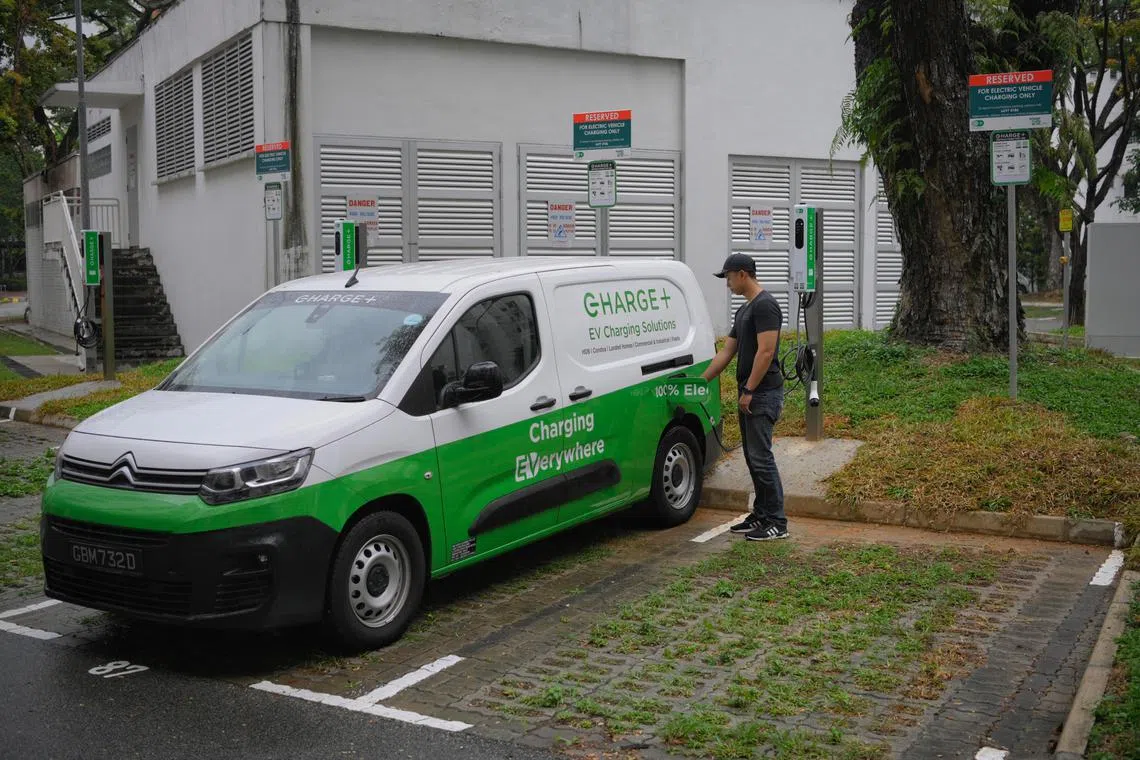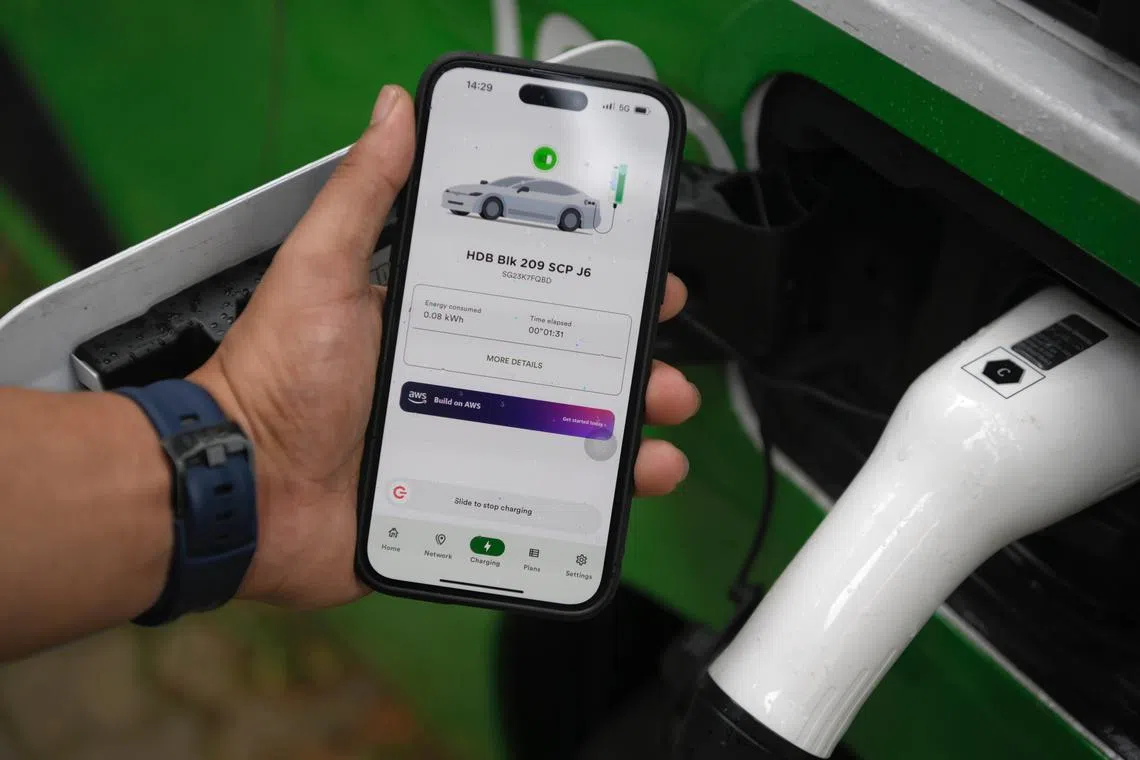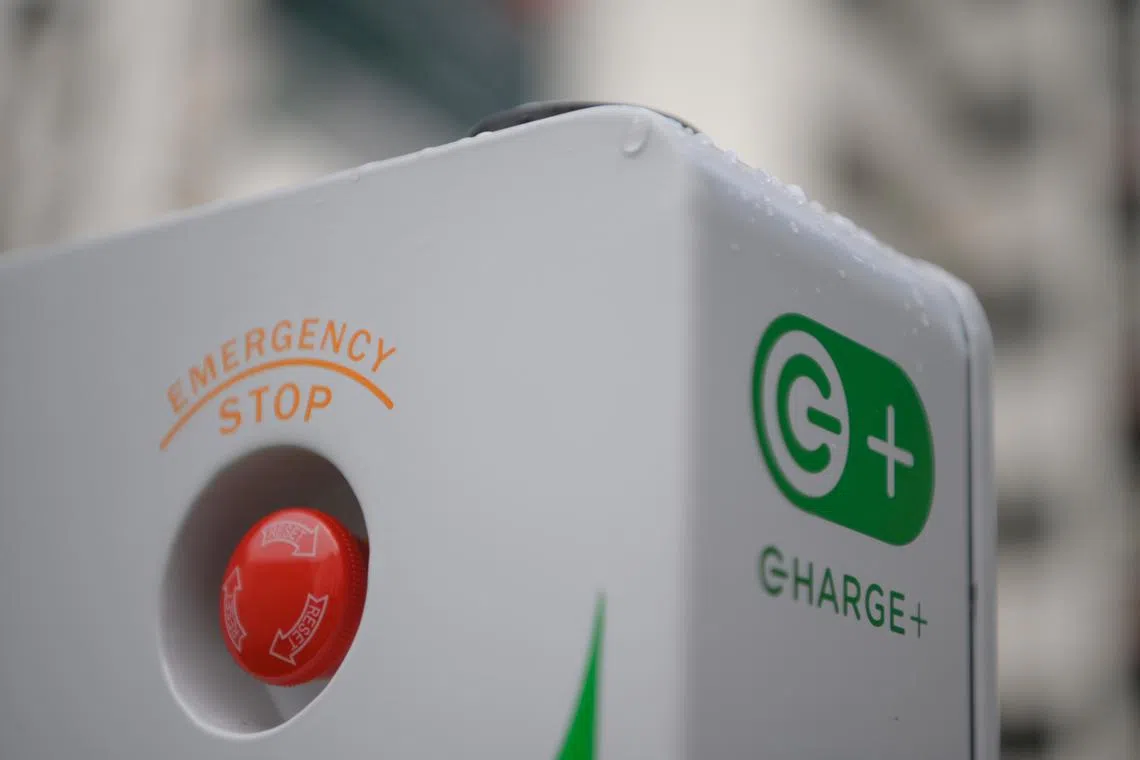First EV chargers rolled out at open-air HDB carpark under large-scale govt project
Sign up now: Get ST's newsletters delivered to your inbox

A public electric vehicle charger at the Block 209 Jurong East Street 21 carpark.
ST PHOTO: MARK CHEONG
Follow topic:
SINGAPORE – For the first time, charging points for electric vehicles (EVs) have been installed at a surface-level Housing Board carpark under a large-scale project to install EV chargers at public carparks.
The six chargers at the surface-level – or open-air – carpark at Block 209 Jurong East Street 21 began operating last Tuesday, and are the latest to be rolled out under a tender awarded in November 2022.
By the end of 2023, there will be 30 surface-level HDB carparks equipped with EV chargers under this scheme, said EV-Electric (EVe) Charging, a subsidiary of the Land Transport Authority (LTA) overseeing the deployment of public EV chargers. These will be installed in Ang Mo Kio, Bedok, Bukit Batok and Bukit Merah.
EV chargers launched earlier were installed in multi-storey HDB carparks. As at Oct 31, EVe has commissioned about 1,600 chargers at 500 public carparks. Another 860 chargers at 240 carparks are in various stages of development.
Under the contract awarded in November 2022, five charging service operators – overseen by EVe – will install at least 12,000 charging points covering nearly 2,000 HDB carparks by 2025.
LTA said it aims to have EV chargers at more than 700 HDB carparks – or about a third of the 2,000 public carparks – by the end of 2023. The first two multi-storey carparks to launch EV chargers under this initiative in February were in Telok Blangah and Boon Lay.
The chargers at the surface-level carpark in Jurong East Street 21 are operated by Charge+. The carpark spaces set aside for EV charging there are located in a row, next to one another.
Around the corner, but still within reach of the charging cables, are motorcycle parking spots. This means it is possible for electric motorcycles to make use of the charging service as well.
Charge+ chief executive Goh Chee Kiong said: “From our experience operating chargers in HDB carparks, the presence of EV chargers will provide confidence and peace of mind to HDB residents to make the switch to EVs.”
At multi-storey carparks, EV charging stations also have motorcycle spots marked out beside the charging spaces for cars.

The Charge+ app during a demonstration at a public electric vehicle charger.
ST PHOTO: MARK CHEONG
Engineer and automotive writer Shreejit Changaroth said there is no issue with charging an EV outdoors when it is raining.
He explained that when plugged in, the charging connectors are sealed against the inflow of water to the same level required for the electrical connections between MRT cars, which transmit much higher voltage than EV chargers.
Furthermore, he said the EV charging system is able to “instantly and totally isolate the charging station from the car when it detects spikes in temperature, electricity current levels or when there is water ingress”.

By the end of 2023, there will be 30 surface-level HDB carparks equipped with EV chargers under this scheme.
ST PHOTO: MARK CHEONG
EVe chief executive Derek Tan said installing EV chargers at surface-level carparks can take two to three months longer than at multi-storey carparks. Progress can be disrupted by bad weather and there is also more to do, including the need for trenching, cabling and road resurfacing.
To deploy EV chargers, operators have to get approval from HDB and apply for power from utilities company SP Group, as well as get clearance from telecommunications operators and the authorities, including LTA, the relevant town council and national water agency PUB, Mr Tan added.
Separately, in August, EVe awarded a three-year contract to NTT Data, a Japanese multinational information technology company, to look at data related to the use of EV chargers on the public charging network.
Information gathered will include the chargers’ real-time availability status and how they are used for the entire network, across different operators.
Mr Tan said analysing such data will help determine where to prioritise future charger locations.
The Electric Vehicles Charging Act will come into force by the end of 2023, after it was passed in November 2022. Among the requirements, operators will need to be licensed and share data with the LTA.
Under the large-scale project, the charging operators have to share data with LTA to ensure that their chargers are usable 97 per cent of the time.
The five operators pay EVe between 10 cents and 21 cents per kilowatt-hour (kWh) of charge they dispense to users through the 7.4kW alternating current chargers. The revenue goes towards upgrading the supporting electrical infrastructure at HDB carparks.
The service is now priced between 54 cents and 59 cents per kWh. For reference, it takes about 9½ hours to fully charge an empty 60.5kWh battery on a BYD Atto 3 at a cost of up to $35.70. This is good for up to 420km of driving distance.
Carmakers said that it is likely that EV drivers will plug in well before the battery is empty. They also recommend keeping the battery charge to between 20 per cent and 80 per cent to prolong the service life.

For reference, it takes around 9½ hours to fully charge an empty 60.5kWh battery on a BYD Atto 3, at a cost of up to $35.70.
ST PHOTO: MARK CHEONG
Outside the current large-scale roll-out of chargers in HDB carparks, TotalEnergies also has chargers located at public surface-level carparks.
These are part of the charging network that the French multi-energy company bought over in 2021 from the owners of BlueSG, who sold the car-sharing service separately to Goldbell Group.
In October, the charging service, known as Bluecharge, was renamed TotalEnergies Charging Services Singapore, with a new mobile app.
A TotalEnergies spokesperson said that of the more than 1,500 charging points across its network, 780 are accessible to all EV drivers, not just BlueSG cars.
The majority of the chargers on its network are 3.7kW AC chargers.
As at the end of September, there were 9,998 electric cars on the road, up 53.1 per cent from 6,531 in end-2022 – forming just 1.5 per cent of Singapore’s car population.
As for motorcycles, only 266 out of the 142,724 units are electric, with fleet owners accounting for the majority.
This article has been edited for clarity.


